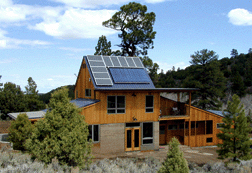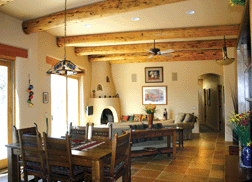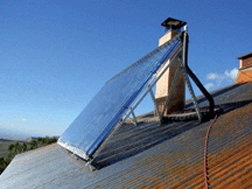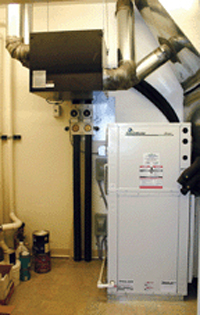smart building for a healthy future
Story by Carol McDermott
All content © San Juan Publishing Group, Inc, All rights reserved.
[SW Colorado] CFLs and LEDs, ENERGY STARS, and
earth-friendly homes—these buzz words say green is the preferred color of construction today. As natural resources dwindle, civilizations adapt to sustain their existence. But it takes more than walls and a roof to build a sustainable future. Tomorrow also relies on efficient use of clean, affordable, reliable energy. High country living in the 21st century meets the challenges with innovation, technology, and élan.

SHELTER
Early environmentally-responsible shelters include tipis and yurts; rammed earth tires and straw bale walls. As construction costs soar, recycle advocates recite their mantra: Reduce, Renew, Recycle, and build or rebuild in innovative,sustainable ways.
With the “Built Green” movement of the 1990s, contractors worked with earth conservators to incorporate clean, efficient construction practices and designs.
Contractor Phil Bailey began his Build Green construction career with a straw bale home for a friend. “I saw the enthusiasm of the earth-friendly practitioners and was caught up in it. Green is a part of being environmentally-friendly because you are conscientious and pay attention to detail,” he said. As a contractor he prefers to be a part of the design decisions. “Orientation to the south, Low-e glass and clear glass selection, stack-framing, which uses 24-inch centers for wall studs, more insulation, these are all important aspects of a systems approach to building.” Bailey believes, “It does not cost any more to build green.
Homebuilders can reduce their square footage and multi-task their space, thereby reducing their cost and saving money, not only in construction, but in energy sustainability. “It’s the right thing to do,” Bailey said. “The more we educate the public, the more aware the public will become. Then we have a chance at reducing our impact on limited resources.”

RENEWABLE ENERGY
Building for a sustainable future includes using efficient and renewable energy resources. Geothermal, solar, and wind-generation are alternatives to the fossil fuels used to produce energy today. Toward that end, energy producers employ “wind farms,” hydroelectric dams, and biomass fuels. With wind energy, long propeller-produce electricity. Most areas of the country have space for like blades catch the wind and whirl turbines to wind farms, which transmit power via regional utility grids into urban areas. A major advantage to electrical production using wind is that it is waterless, unlike hydroelectric plants and steam-driven generators. Wind power creates no emissions. In addition, several companies have residential wind power systems available for half acre properties with unobstructed views and compatible zoning. (www.headwatersenergy.com)
Water is absolutely necessary for hydroelectric production and for steam-spun turbines. Rivers and reservoirs send water through penstocks to turn turbines, producing electricity. Therefore, hydroelectric plants depend on location—of water in dependable quantities. Utility companies which burn coal or natural gas turn water into steam to generate electricity. Recent innovations have made methane recovered from landfills or from anaerobic digesters, agricultural biomass, and animal waste, into fuel for steam-powered plants.

SOLAR
On a smaller scale, businesses and residences can generate the power they need through solar panels. Leif Juell, Alternative Power Enterprises, said that contractors who use an integrated building approach, can laminate solar collectors into the roof itself, or install solar modules above atriums and carports. Solar water radiant heating systems are also available, he said. According to the U.S. Department of Energy, photovoltaics, usually roof panels, produce clean, non-polluting energy. They are versatile regarding size and installation, reliable, attractive, and easy to operate. (www.eren.doe.gov) Passive solar doesn’t generate electricity, but reduces the need for it to heat space. Passive solar is the positioning of a home to maximize exposure to the sun during the winter, and constructing it to minimize solar input during the summer, an easy, efficient way to conserve natural resources and economize financially

GEOTHERMAL
Another sustainable energy source is geothermal, which uses the earth to heat/cool water, conserving electrical usage. Since between 40-60 percent of a household’s electric consumption is used to heat the residence in the winter and cool it during the summer geothermal systems are an efficient alternative source of energy. The Bailey-built home pictured below left, which depends on geothermal, has an ENERGY STAR rating of 91 percent (as opposed to a typical “stick built” structure, which is about 69 percent). To further energy efficiency, it is constructed of hollow Dura-Block exterior walls filled with solid concrete and insulated with spray foam. Floor and ceilings are also insulated. Cellulose insulation fills interior walls. The roof is “hot mop” covered with gravel. Windows are Low-e double glazed. “It’s virtually sound proof,” explain the owners, adding that the expected annual energy Energy efficiency is the cornerstone in building a sustainable future. “It’s going to be conservation that drives us,” said James Heneghan, DMEA Energy Services Supervisor. “We need a reduction of consumption and less dependence on fossil fuels.”
In Hotchkiss, the fire district just completed construction of a new fire station which uses a solar array, and sprayed foam insulation to reduce air infiltration. In Paonia, the new public library, expected to open its doors in 2009, benefits from a $25,000 DMEA grant to incorporate energy saving features. The U.S. Department of Energy (DOE) is also helping. Through ENERGY STAR ratings, consumers choose appliances that are earth-friendly and cost effective. Contractors who follow ENERGY STAR guidelines can earn significant financial reductions in their taxes. And homeowners can qualify for an energy loan, using their savings over time (payback period) as collateral.
ENVIRONMENTAL
“Across the nation, government groups, consumers, and communities are embracing the benefits of applying sustainable and high performance design standards to building architecture,” according to Sue McIntosh, environmental coordinator for Cornerstone, a planned community in Ouray and Montrose counties.“Consumers are becoming more knowledgeable about green building alternatives and are seeking the economic and health benefits derived from them,” she said. Like other conservation-minded developers, Cornerstone has recommendations for homeowners and their contractors that embody xeriscape outside, ENERGY STAR efficiency inside, and many Green Build strategies in the basic construction, including the use of renewable or recycled resources and materials, and low toxicity and low emissions paints. Water conservation practices are also endorsed, such as erosion control and the use of drought tolerant plants in landscaping.
Photography
House utilizing photovoltaic panels to produce electricity and tubular panels for hot water. Courtesy Alternative Power Enterprises.
Concrete home, utilizing a geothermal heat pump, has an ENERGY STAR rating of 96 percent and incorporates multiple energy-saving systems. © Kathryn R. Burke
Evacuated tube solar hot water collectors. Courtesy Alternative Power Enterprises
Heat pump attached to 820 foot earth loop connection six foot deep keeps home a comfortable 72-75 degrees year-round. © Kathryn R. Burke
References & Additional Links
Built Green
Energy & Environmental Building Alliance (EEBA)
GeoExchange
Delta Montrose Electric Association
San Miguel Power Association
Energy Star
Rye Home Energy Consulting & House Planning
Habitat for Humanity
